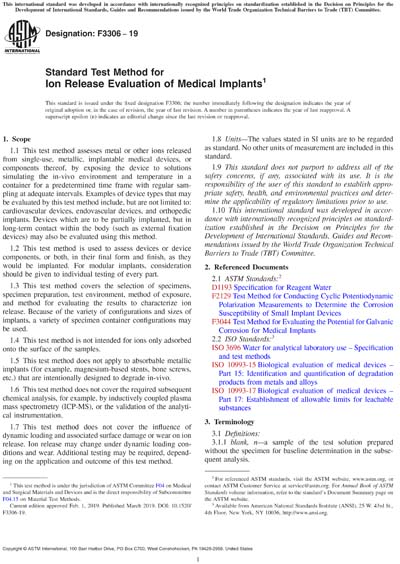Most recent
ASTM F3306-19
Standard Test Method for Ion Release Evaluation of Medical Implants
1.1 This test method assesses metal or other ions released from single-use, metallic, implantable medical devices, or components thereof, by exposing the device to solutions simulating the in-vivo environment and temperature in a container for a predetermined time frame with regular sampling at adequate intervals. Examples of device types that may be evaluated by this test method include, but are not limited to: cardiovascular devices, endovascular devices, and orthopedic implants. Devices which are to be partially implanted, but in long-term contact within the body (such as external fixation devices) may also be evaluated using this method.
1.2 This test method is used to assess devices or device components, or both, in their final form and finish, as they would be implanted. For modular implants, consideration should be given to individual testing of every part.
1.3 This test method covers the selection of specimens, specimen preparation, test environment, method of exposure, and method for evaluating the results to characterize ion release. Because of the variety of configurations and sizes of implants, a variety of specimen container configurations may be used.
1.4 This test method is not intended for ions only adsorbed onto the surface of the samples.
1.5 This test method does not apply to absorbable metallic implants (for example, magnesium-based stents, bone screws, etc.) that are intentionally designed to degrade in-vivo.
1.6 This test method does not cover the required subsequent chemical analysis, for example, by inductively coupled plasma mass spectrometry (ICP-MS), or the validation of the analytical instrumentation.
1.7 This test method does not cover the influence of dynamic loading and associated surface damage or wear on ion release. Ion release may change under dynamic loading conditions and wear. Additional testing may be required, depending on the application and outcome of this test method.
1.8 Units—The values stated in SI units are to be regarded as standard. No other units of measurement are included in this standard.
1.9 This standard does not purport to address all of the safety concerns, if any, associated with its use. It is the responsibility of the user of this standard to establish appropriate safety, health, and environmental practices and determine the applicability of regulatory limitations prior to use.
1.10 This international standard was developed in accordance with internationally recognized principles on standardization established in the Decision on Principles for the Development of International Standards, Guides and Recommendations issued by the World Trade Organization Technical Barriers to Trade (TBT) Committee.
Content Provider
ASTM International [astm]






